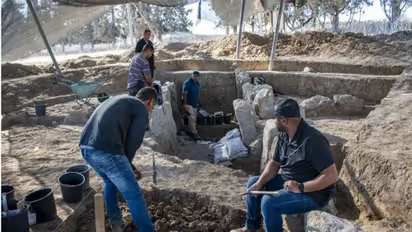In Pictures: 5,000-year-old gate unearthed in Israel, offers insights into ancient urbanization

Synopsis
Archaeologists uncover Israel's oldest gate, a 5,500-year-old structure leading to Tel Erani, shedding light on ancient urbanization and strategic defence.
In a momentous archaeological revelation, the Israel Antiquities Authority has disclosed the unearthing of Israel's oldest known gate, an imposing stone and mud-brick structure leading to the ancient city of Tel Erani. The discovery, made during excavations near Kiryat Gat's industrial zone before a water pipeline installation, dates back 5,500 years.
Researchers uncovered not only the gate but also a portion of a fortification system from the Early Bronze Age, approximately 3,300 years ago, during their excavation in Tel Erani. This remarkable find holds valuable insights into the strategic defense and growth of urban centers in ancient times.
According to Emily Bischoff, Director of the excavation on behalf of the Israel Antiquities Authority, this monumental gate, dating to the Early Bronze IB period, is a groundbreaking discovery. "This is the first time that such a large gate dating to the Early Bronze IB has been uncovered. To construct the gate and the fortification walls, stones had to be brought from a distance, mudbricks had to be manufactured, and the fortification walls had to be constructed. This was not achieved by one or a few individuals. The fortification system is evidence of social organization that represents the beginning of urbanization," said Bishchoff.
Martin-David Pasternak, an Israel Antiquities Authority researcher, notes that the gate likely served as a significant checkpoint for all individuals, including traders and potential foes, entering the city.
Dr. Yitzhak Paz, an Israel Antiquities Authority archaeologist specializing in the Early Bronze Age period, emphasizes the importance of the find in redefining the onset of urbanization in the region. "Tell Erani, which is about 150 dunams in size, was an important early urban center in this area in the Early Bronze period. The Tell site was part of a large and important settlement system in the southwestern area of the country during this period. Within this system, we can identify the first signs of the urbanization process, including settlement planning, social stratification, and public building," Paz said.
"The newly uncovered gate is an important discovery that affects the dating of the beginning of the urbanization process in the country. The extensive excavations carried out by the Israel Antiquities Authority over recent years have led to dating the beginning of urbanization to the end of the fourth millennium BCE, but the excavations carried out at Tell Erani have now shown that this process began even earlier, in the last third of the fourth millennium BCE," he added.
Tel Erani, occupying a 150-dunam (37-acre) site and linked to the ancient Philistines, emerges as a pivotal early urban center within the Kiryat Gat vicinity. The city, which stands near present-day Kiryat Gat, met its end in the 6th Century BCE, likely due to Babylonian destruction.
This archaeological triumph not only sheds light on ancient architectural marvels but also unravels layers of historical development, offering a glimpse into the evolution of urbanization and society during a time long past.
Check the Breaking News Today and Latest News from across India and around the world. Stay updated with the latest World News and global developments from politics to economy and current affairs. Get in-depth coverage of China News, Europe News, Pakistan News, and South Asia News, along with top headlines from the UK and US. Follow expert analysis, international trends, and breaking updates from around the globe. Download the Asianet News Official App from the Android Play Store and iPhone App Store for accurate and timely news updates anytime, anywhere.